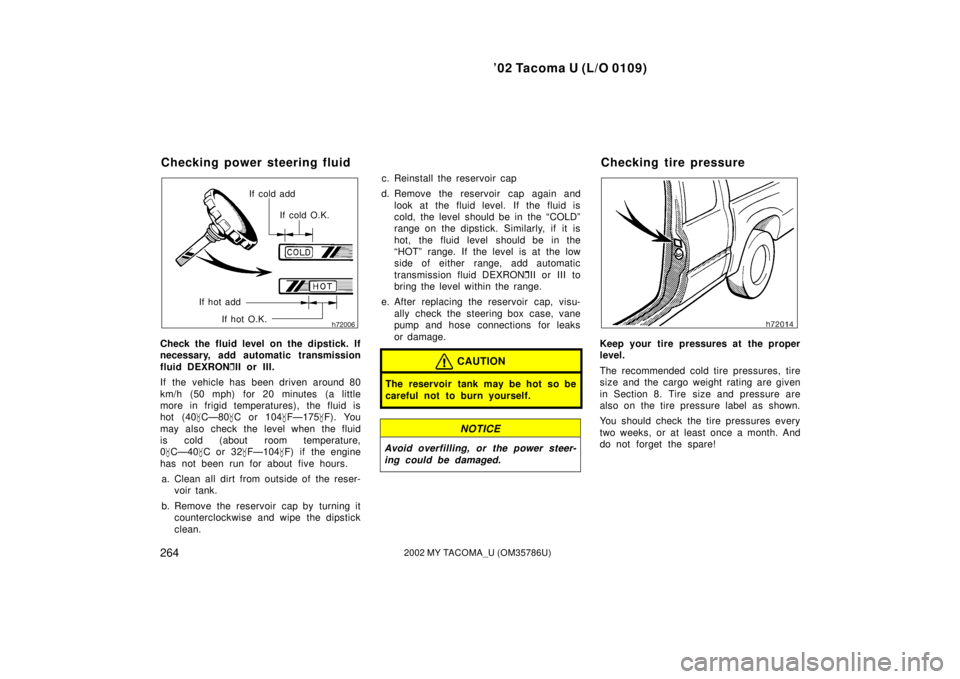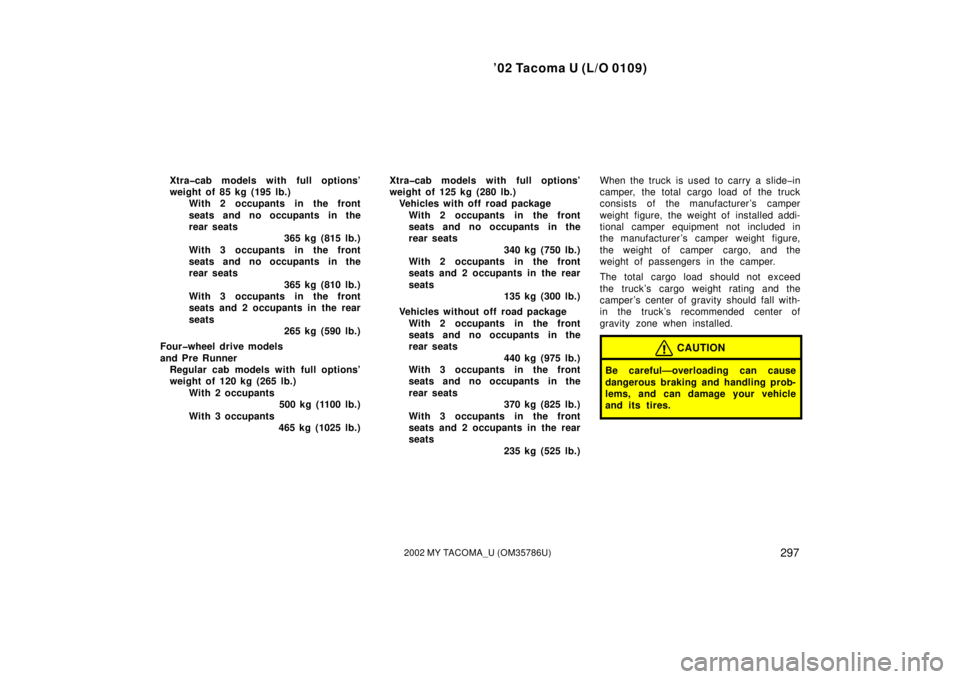Page 270 of 308

’02 Tacoma U (L/O 0109)
2642002 MY TACOMA_U (OM35786U)
If cold addIf cold O.K.
If hot add If hot O.K.
Check the fluid level on the dipstick. If
necessary, add automatic transmission
fluid DEXRON �II or III.
If the vehicle has been driven around 80
km/h (50 mph) for 20 minutes (a little
more in frigid temperatures), the fluid is
hot (40 �C—80 �C or 104 �F—175 �F). You
may also check the level when the fluid
is cold (about room temperature,
0 �C—40 �C or 32 �F—104 �F) if the engine
has not been run for about five hours.
a. Clean all dirt from outside of the reser- voir tank.
b. Remove the reservoir cap by turning it counterclockwise and wipe the dipstick
clean. c. Reinstall the reservoir cap
d. Remove the reservoir cap again and look at the fluid level. If the fluid is
cold, the level should be in the “COLD”
range on the dipstick. Similarly, if it is
hot, the fluid level should be in the
“HOT” range. If the level is at the low
side of either range, add automatic
transmission fluid DEXRON �II or III to
bring the level within the range.
e. After replacing the reservoir cap, visu- ally check the steering box case, vane
pump and hose connections for leaks
or damage.
CAUTION
The reservoir tank may be hot so be
careful not to burn yourself.
NOTICE
Avoid overfilling, or the power steer-
ing could be damaged.
Keep your tire pressures at the proper
level.
The recommended cold tire pressures, tire
size and the cargo weight rating are given
in Section 8. Tire size and pressure are
also on the tire pressure label as shown.
You should check the tire pressures every
two weeks, or at least once a month. And
do not forget the spare!
Checking power steering fluid Checking tire pressure
Page 271 of 308

’02 Tacoma U (L/O 0109)
2652002 MY TACOMA_U (OM35786U)
Incorrect tire pressure can reduce tire
life and make your vehicle less safe to
drive.
Low tire pressure results in excessive
wear, poor handling, reduced fuel econo-
my, and the possibility of blowouts from
overheated tires. Also, low tire pressure
can cause poor sealing of the tire bead.
If the tire pressure is excessively low,
there is the possibility of wheel deforma-
tion and/or tire separation.
High tire pressure produces a harsh ride,
handling problems, excessive wear at the
center of the tire tread, and a greater
possibility of tire damage from road haz-
ards.
If a tire frequently needs ref illing, have it
checked by your Toyota dealer. The following instructions for checking
tire pressure should be observed:
�The pressure should be checked only
when the tires are cold.
If your ve-
hicle has been parked for at least 3
hours and has not been driven for
more than 1.5 km or 1 mile since, you
will get an accurate cold tire pressure
reading.
�Always use a tire pressure gauge.
The appearance of a tire can be mis-
leading. Besides, tire pressures that
are even just a few pounds off can
degrade ride and handling
�Do not bleed or reduce tire pressure
after driving. It is normal for the tire
pressure to be higher after driving.
�Never exceed the cargo weight rat-
ing. The luggage weight should be dis-
tributed evenly.
�Be sure to reinstall the tire inflation
valve caps. Without the valve caps,
dirt or moisture could get into the valve
core and cause air leakage. If the caps
have been lost, have new ones put on
as soon as possible.
Tread wear indicator
CHECKING YOUR TIRES
Check the tire tread for the tread wear
indicators. If the indicators show, re-
place the tires.
The tires on your Toyota have built�in
tread wear indicators to help you know
when the tires need replacement. When
the tread depth wears to 1.6 mm (0.06
in.) or less, the indicators will appear. If
you can see the indicators in two or more
adjacent grooves, the tire should be re-
placed. The lower the tread, the higher
the risk of skidding.
The effectiveness of snow tires is lost
if the tread wears down below 4 mm
(0.16 in.).
Checking and replacing tires
Page 275 of 308
’02 Tacoma U (L/O 0109)
2692002 MY TACOMA_U (OM35786U)
�When installing aluminum wheels,
check that the wheel nuts are tight
after driving your vehicle the first 1600
km (1000 miles).
�If you have rotated, repaired, or
changed your tires, check that the
wheel nuts are still tight after driving
1600 km (1000 miles).
�When using tire chains, be careful not
to damage the aluminum wheels.
�Use only the Toyota wheel nuts and
wrench designed for your aluminum
wheels.
�When balancing your wheels, use only
Toyota balance weights or equivalent
and a plastic or rubber hammer.
�As with any wheel, periodically check
your aluminum wheels for damage. If
damaged, replace immediately.
Aluminum wheel precautions
Page 302 of 308
’02 Tacoma U (L/O 0109)
2962002 MY TACOMA_U (OM35786U)
B
A
Rear end of truck bed
Recommended location
for cargo center of
gravity for cargo
weight rating
Two�wheel drive models
except Pre Runner mm (in.)
AB
Regular cab
models1397
(55.0)965
(38.0)
Xtra�cab models 2RZ�FE engine
5VZ�FE engine
1372
(54.0) 1397
(55.0)927
(36.5) 927
(36.5)
Four�wheel drive models
and Pre Runner mm (in.)
A
B
1257
(49.5)901
(35.5)
The figures given in the illustration indi-
cate the recommended center of gravity
zone.
CAUTION
If a load is too far back, it can cause
dangerous handling. If it is too far
forward, the front axle may be over-
loaded.
Camper center of gravity
Recommended center of
gravity location zone
Cargo weight rating
Two�wheel drive models
except Pre Runner Regular cab models with full options’
weight of 90 kg (205 lb.) With 2 occupants 430 kg (950 lb.)
With 3 occupants 375 kg (830 lb.)
—Center of gravity location —Cargo weight rating and
proper matching
Page 303 of 308

’02 Tacoma U (L/O 0109)
2972002 MY TACOMA_U (OM35786U)
Xtra�cab models with full options’
weight of 85 kg (195 lb.)With 2 occupants in the front
seats and no occupants in the
rear seats 365 kg (815 lb.)
With 3 occupants in the front
seats and no occupants in the
rear seats 365 kg (810 lb.)
With 3 occupants in the front
seats and 2 occupants in the rear
seats 265 kg (590 lb.)
Four�wheel drive models
and Pre Runner Regular cab models with full options’
weight of 120 kg (265 lb.)
With 2 occupants 500 kg (1100 lb.)
With 3 occupants 465 kg (1025 lb.) Xtra�cab models with full options’
weight of 125 kg (280 lb.)
Vehicles with off road package
With 2 occupants in the front
seats and no occupants in the
rear seats 340 kg (750 lb.)
With 2 occupants in the front
seats and 2 occupants in the rear
seats 135 kg (300 lb.)
Vehicles without off road package With 2 occupants in the front
seats and no occupants in the
rear seats 440 kg (975 lb.)
With 3 occupants in the front
seats and no occupants in the
rear seats 370 kg (825 lb.)
With 3 occupants in the front
seats and 2 occupants in the rear
seats 235 kg (525 lb.) When the truck is used to carry a slide�in
camper, the total cargo load of the truck
consists of the manufacturer ’s camper
weight figure, the weight of installed addi-
tional camper equipment not included in
the manufacturer ’s camper weight figure,
the weight of camper cargo, and the
weight of passengers in the camper.
The total cargo load should not exceed
the truck’s cargo weight rating and the
camper ’s center of gravity should fall with-
in the truck’s recommended center of
gravity zone when installed.
CAUTION
Be careful—overloading can cause
dangerous braking and handling prob-
lems, and can damage your vehicle
and its tires.
Page 304 of 308

’02 Tacoma U (L/O 0109)
2982002 MY TACOMA_U (OM35786U)
Gross axle weight ratingFront GAWR Rear GAWR
Secure loose items to prevent weight
shifts that could affect the balance of your
vehicle. When the truck camper is loaded,
drive to a scale and weigh on the front
and on the rear wheels separately to de-
termine axle loads. Individual axle loads
should not exceed either of the Gross
Axle Weight Ratings (GAWR). The total of
the axle loads should not exceed the
Gross Vehicle Weight Rating (GVWR).
These ratings are given on the vehicle
Certification Label which is located on the
door latch post on the left side of the
vehicle. See “Your Toyota’s identification”
in Section 2 for the Certification Label
location. If weight ratings are exceeded,
move or remove items to bring all weights
below the ratings.
Gross vehicle weight rating
Not exceed GVWR
GAWR
Two�wheel drive models
except Pre RunnerFront 1000 kg (2200 lb.)
Rear 1135 kg (2500 lb.)
Four�wheel drive models
and Pre Runner Front 1200 kg (2650 lb.)
Rear 1270 kg (2800 lb.) GVWR
Two�wheel drive models
except Pre Runner
Regular cab models 1920 kg (4250 lb.)
Xtra�cab models
2040 kg (4500 lb.)
Four�wheel drive models
and Pre Runner 2315 kg (5100 lb.)
If weight ratings are exceeded, move or
remove items to bring all weights below
the ratings.
—Gross axle and vehicle
weight ratings